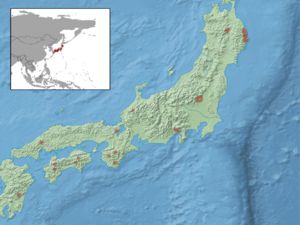Frosted myotis facts for kids
Quick facts for kids Frosted myotis |
|
|---|---|
| Conservation status | |
| Scientific classification | |
| Genus: |
Myotis
|
| Species: |
pruinosus
|
 |
|
The frosted myotis (Myotis pruinosus) is a small type of vesper bat. It gets its name from the light, "frosted" tips on its fur. This special bat is found only in Japan.
Contents
About the Frosted Myotis
Who Discovered This Bat?
A scientist named Kimio Endo first found the frosted myotis in August 1969. Then, in 1971, another scientist, Mizuko Yoshiyuki, officially described it. This means she gave it its scientific name and wrote about its features.
The frosted myotis is closely related to other bats like the Yanbaru whiskered bat and the Burmese whiskered bat. Scientists believe that the ancestors of the frosted myotis came from areas south of Japan. Over a long time, they slowly spread northward.
What Does This Bat Look Like?
The frosted myotis is a small bat. Its forearm, which is part of its wing, is about 30 to 33 millimeters (1.2 to 1.3 inches) long. That's about the length of a paperclip!
Its fur is a brownish color on its back. The tips of these hairs are lighter, making them look "frosted." The fur on its belly is a bit lighter than its back. The fur feels soft and velvety, and each hair is about 5.5 millimeters (0.2 inches) long. Its wings are dark brown.
The ears of the frosted myotis are narrow and short. Inside its ear, there's a small flap called a tragus. This tragus is about half as tall as the ear itself. This bat has 38 teeth in total.
Where Does This Bat Live?
The frosted myotis mostly lives in mountain forests that are not too high up. You can find them at elevations of about 200 to 300 meters (650 to 980 feet) above sea level.
They have been seen on three main islands of Japan: Honshu, Shikoku, and Kyushu.
How Does This Bat Live?
During the day, the frosted myotis likes to rest and sleep inside tree hollows. These are natural holes or spaces found inside large trees. Because they depend on these hollows, you won't find them in places where there aren't big trees with suitable holes.
Protecting the Frosted Myotis
Why Is This Bat Endangered?
The International Union for Conservation of Nature (IUCN) says the frosted myotis is an endangered species. This means it's at a high risk of disappearing forever.
There are several reasons why this bat is in danger:
- The area where it lives is very small, less than 5,000 square kilometers (1,900 square miles).
- Its habitat is broken up into many small pieces, which makes it hard for bats to move around.
- Scientists believe that the places where these bats live are getting smaller and worse in quality.
- The number of frosted myotis bats is also believed to be going down.
What Are the Main Threats?
The biggest dangers to the frosted myotis are habitat destruction and forest fragmentation. Habitat destruction means that the places where they live are being destroyed. Forest fragmentation means that large forests are being cut into smaller, separate pieces. This makes it harder for bats to find food, shelter, and other bats.


